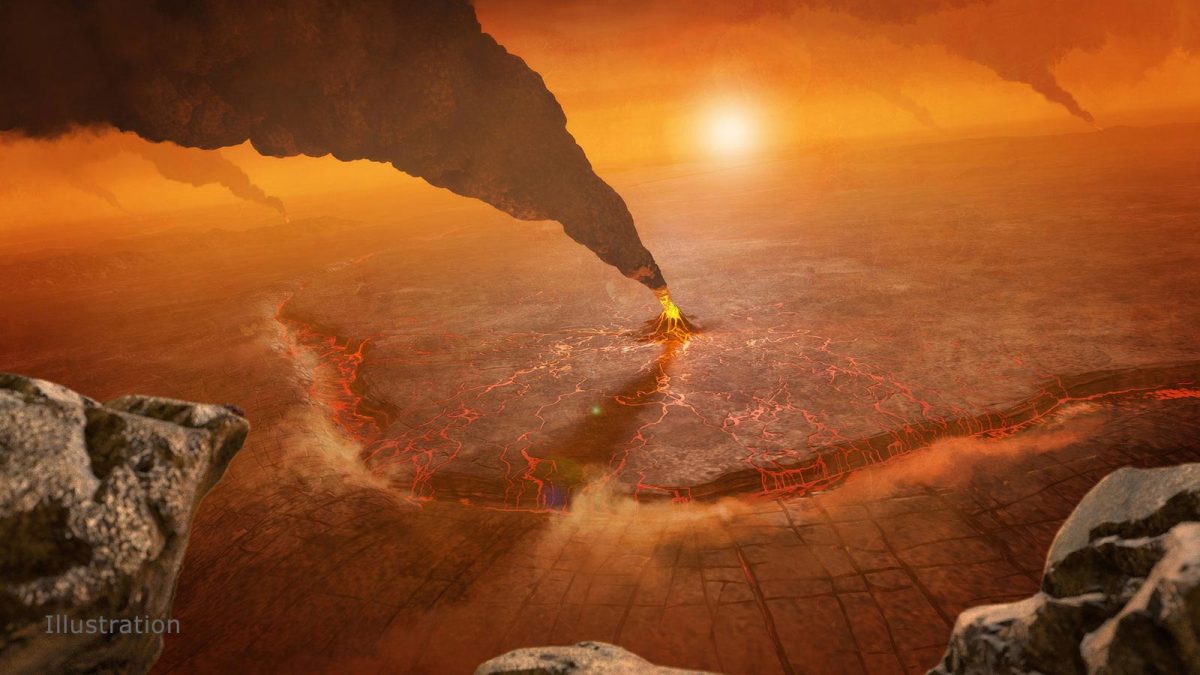An artist’s concept of active volcanos on Venus, depicting a subduction zone where the foreground crust plunges into the planet’s interior at the topographic trench. Credit: NASA/JPL-Caltech/Peter Rubin
Venus may have been transformed from a temperate and wet world to the acidic hothouse it is today with help from vast volcanic activity lasting hundreds to thousands of centuries and erupting massive amounts of material. This is according to a scientific paper authored by NASA researchers, which was published earlier this year in The Planetary Science Journal.
These “large igneous provinces” in Earth’s history, which caused several mass extinctions on our own planet millions of years ago, are also discussed in the paper.
“By understanding the record of large igneous provinces on Earth and Venus, we can determine if these events may have caused Venus’ present condition,” said Dr. Michael J. Way, of NASA’s Goddard Institute for Space Studies in New York. Way is lead author on the Planetary Science Journal paper.

Maat Mons is displayed in this computer-generated, three-dimensional perspective of the surface of Venus. The viewpoint is located 634 kilometers (393 miles) north of Maat Mons at an elevation of 3 kilometers (2 miles) above the terrain. Lava flows extend for hundreds of kilometers across the fractured plains shown in the foreground, to the base of Maat Mons. NASA Magellan mission synthetic aperture radar data is combined with radar altimetry to develop a three-dimensional map of the surface. The vertical scale in this perspective has been exaggerated 10 times. Credit: NASA/JPL
Large igneous provinces are the results of long periods of large-scale volcanism lasting tens of thousands or even hundreds of thousands of years. They can deposit more than 100,000 cubic miles of volcanic rock onto the surface. At the upper end, this would be enough to bury the entire state of Texas in molten rock half a mile deep.
Today, Venus boasts surface temperatures of around 864 °F (462 °C) on average, and an atmosphere 90 times the surface pressure of Earth’s. According to the study, these massive volcanic outpourings may have initiated these conditions sometime in Venus’ ancient history. In particular, the occurrence of several such eruptions in a short span of geologic time (within a million years) could have led to a runaway greenhouse effect which kicked off the planet’s transition from wet and temperate to hot and dry.
In total, 80% of Venus’ surface is coved by large fields of solidified volcanic rock, Way said. “While we’re not yet sure how often the events which created these fields occurred, we should be able to narrow it down by studying Earth’s own history.”

Maat Mons, a large volcano on Venus, is shown in this 1991 simulated-color radar image from NASA’s Magellan spacecraft mission. Credit: NASA/JPL
Since the origin of multicellular life about 540 million years ago, life on Earth has endured at least five major mass extinction events. Each of these wiped out more than 50% of animal life across the planet. According to this study and others before it, the majority of these extinction events were caused or exacerbated by the kinds of eruptions that produce large igneous provinces. In Earth’s case, the climate disruptions from these events were not sufficient to cause a runaway greenhouse effect as they were on Venus, for reasons that Way and other scientists are still working to determine.
NASA’s next missions to Venus, scheduled for launch in the late 2020s – the Deep Atmosphere Venus Investigation of Noble gases, Chemistry, and Imaging (DAVINCI) mission and the Venus Emissivity, Radio science, InSAR, Topography, And Spectroscopy (VERITAS) mission – aim to study the origin, history, and present state of Venus in unprecedented detail.
“A primary goal of DAVINCI is to narrow down the history of water on Venus and when it may have disappeared, providing more insight into how Venus’ climate has changed over time,” Way said.
The DAVINCI mission will precede VERITAS, an orbiter designed to investigate the surface and interior of Venus from high above, to better understand its volcanic and volatile history and thus Venus’ path to its current state. The data from both missions could help scientists to narrow down the exact record of how Venus may have transitioned from wet and temperate to dry and sweltering. It may also help us to better understand how volcanism here on Earth has affected life in the past, and how it may continue to do so in the future.
Reference: “Large-scale Volcanism and the Heat Death of Terrestrial Worlds” by M. J. Way, Richard E. Erns and Jeffrey D. Scargle, 26 April 2022, The Planetary Science Journal.
DOI: 10.3847/PSJ/ac6033
This study was supported by Goddard Space Flight Center’s Sellers Exoplanet Environments Collaboration (SEEC) and was part of NASA’s Nexus for Exoplanet System Science (NExSS) RCN.
Share your story or advertise with us: Whatsapp: +2347068606071 Email: info@newspotng.com











![Ondo election: ‘I’m not aware people bought votes on my behalf’ – Aiyedatiwa [VIDEO]](https://newspotng.com/wp-content/uploads/2023/01/Imo-PDP-in-shock-over-cancellation-of-Orlu-senatorial-primaries-324x235.png)



